The Drum Majors of Chess: Part Two
Chess enthusiasts and supporters,
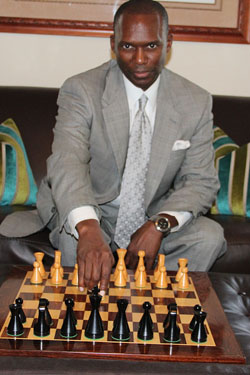
Last week in Part One, we looked at the genesis of chess with the Moors. In subsequent activity hundreds of years later, the descendants of slaves took up the game that their ancestors had once enjoyed. Of course, not much is known about chess in Moorish Spain since many of the documents were burned after the Moors were driven from Spain in 1492. There remains so much history that was either lost or yet to be uncovered about chess among Black people.
Last week, we focused on the 19th century Black pioneers in America. This week, we will look at a number of locations that resulted in chess growth during the 20th century. One such event that propelled chess forward in the Black community was the so-called “Fischer Boom”. Born in Chicago, but raised in Brooklyn, Bobby Fischer’s championship in 1972 ignited an excitement in an entire generation of players throughout the globe. Many Black players (far and wide) would learn chess and as a result, some became a part of the surge of chess masters in the 70s and 80s.
Enjoy!
Dr. Daaim Shabazz, The Chess Drum
The Drum Majors of Chess:
The Rise of the Black Chess Master
Cuba’s contributions to chess are understated, but this country of now 11 million was seminal to the growth of chess in the early 20th century. Chess found fertile soil on this island in part because the revolutionary fervor that enraptured the country in its fight against Spain. One of the national heroes from the revolution was Lieutenant General Antonio Maceo, a supreme battle strategist and slavery abolitionist whose valor was highly revered. While he is not known to have played chess, he played a role in shaping a national consciousness that set the stage for a post-colonial Cuba. He was known in battle as the “Bronze Titan” due to his African features.
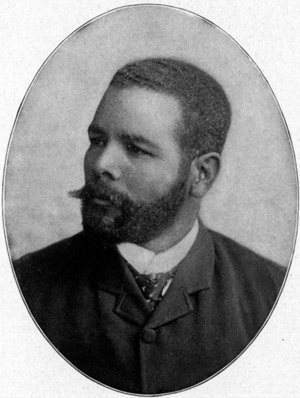
Lieutenant General José Antonio Maceo y Grajales, a national hero of Cuba help set the national consciousness with his valor and strategic outlook in the war against Spanish occupation.
With such a national consciousness, Jose Raul Capablanca championship feats from 1921-1927 were welcomed, recognized and supported. Capablanca rose out of privilege in Cuba where he learned chess, but lived much of his adult life in New York and created a wave of chess enthusiasm that would be repeated decades later with so-called “Fischer Boom” of chess. Meanwhile in Cuba, a man by the name of Rogelio Ortega rose to prominence after Capablanca’s death. He played in five Olympiads for Cuba and won the National Championship in 1966. Ortega competed against the best of his day.
(Note: Ortega’s list of opponents reads like a Hall-of-Fame and includes Mikhail Tal, Boris Spassky, Vassily Smyslov, Yefim Geller, Lajos Portisch, Samuel Reshevsky, Miguel Najdorf, Nicolas Rossolimo, David Bronstein, Seymon Furman, Israel Horowitz, Wolfgang Uhlmann)
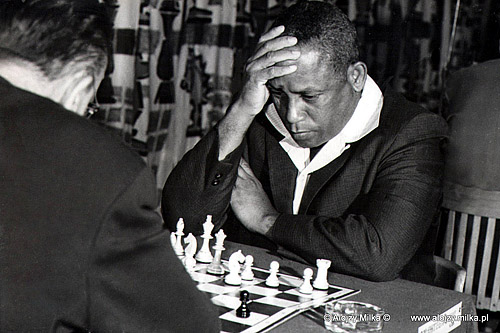
Rogelio Ortega in Zdroj, Poland in 1967.
Photo by Alojzy Milka (courtesy of Dariusz Milka).
That same year Cuba hosted the Chess Olympiad at the Habana Libre Hotel and where Bobby Fischer would score an incredible 15/17! It is interesting how the Capablanca-New York-Fischer connection is made. Capablanca died a year before Fischer was born, but trod the paths the future champion would walk a decade later. The Cuban maestro made an impression on the Brooklyn-bred phenom who was said to have appreciated the champion’s brash confidence.
When Fischer defeated Boris Spassky to become World Champion in 1972, there was a lot happening around the world. Middle East politics were boiling, the Olympic Games in Munich would become infamous for a tragedy, nascent African and the Caribbean nations were trying to find their footing, the fight against apartheid was afoot and America was testing its new democracy in recognizing full citizenship rights for Blacks. Nevertheless, the Fischer victory shone through and captured the imagination of many.
Walter Harris, America’s first Black Master recounted his interactions with Fischer including blitz sessions where Harris received two minutes to Fischer’s 30 seconds!
Fischer’s victory over the Soviet machine had other important effects in that it was a source of motivation for those around the world who saw that a narrow focus and hard work could produce results even when facing a team. The 1972 match featured an unrelenting and brash Fischer who defied odds and looked good doing it. With this new champion, the “Fischer Boom” was created and thousands in America taught their children chess.
Leading up to Fischer’s ascendancy, a handful of Black players emerged. One of them was Walter Harris a bespectacled New York native and Fischer contemporary who made Master shortly after playing in the 1959 U.S. Junior Championship as a 17-year old. In interviewing Harris over the years, he recounts the day he met a teenage Fischer with great clarity.
According to Harris, he was introduced to Fischer by Archie Waters, an older man who served as a type of mentor to both. When Harris told Fischer of his chess endeavors, the young master remarked that he saw talent in Harris’ game. His interactions with Fischer at the Manhattan Chess Club also included blitz sessions where Harris received two minutes to Fischer’s 30 seconds!
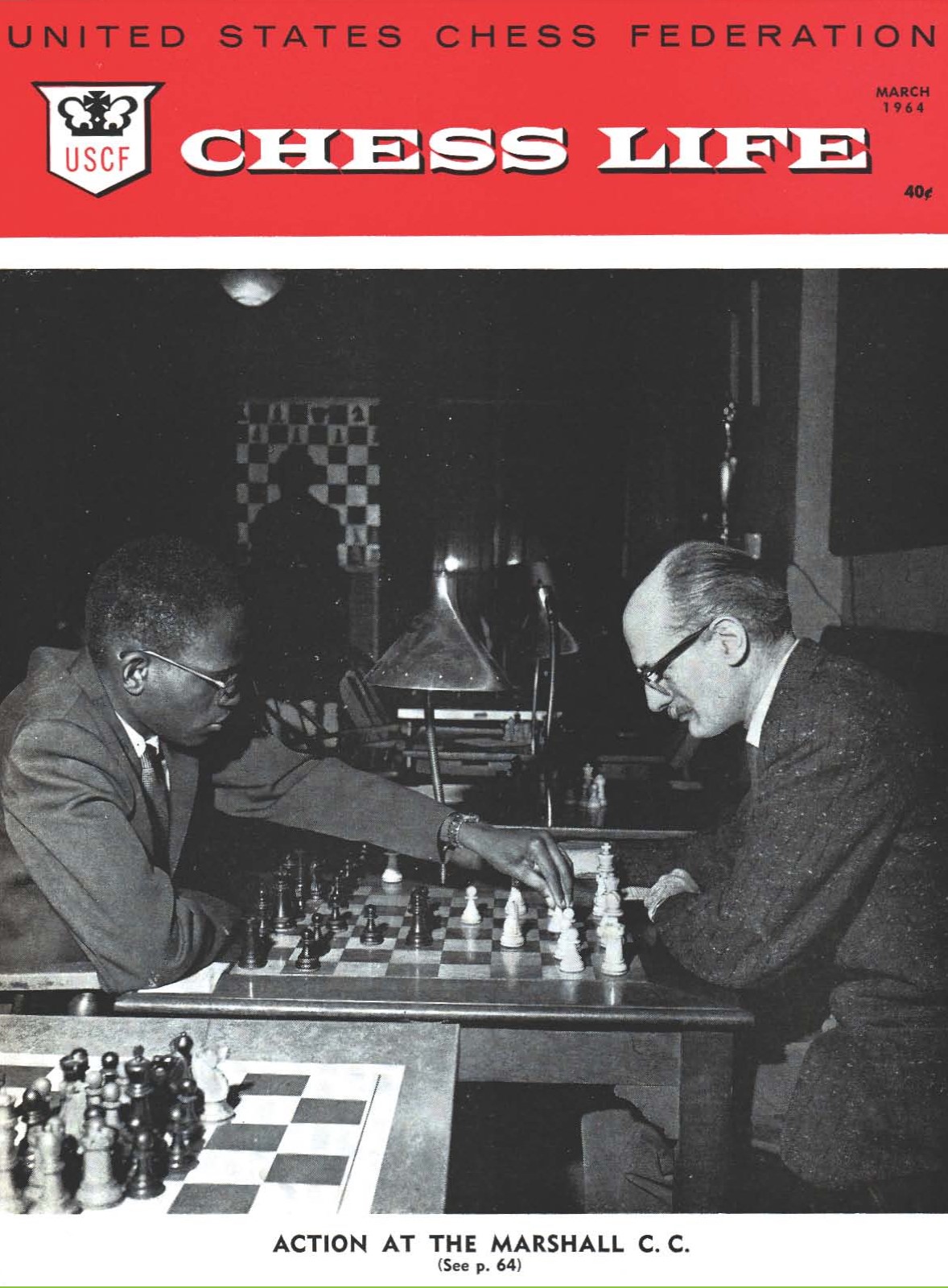
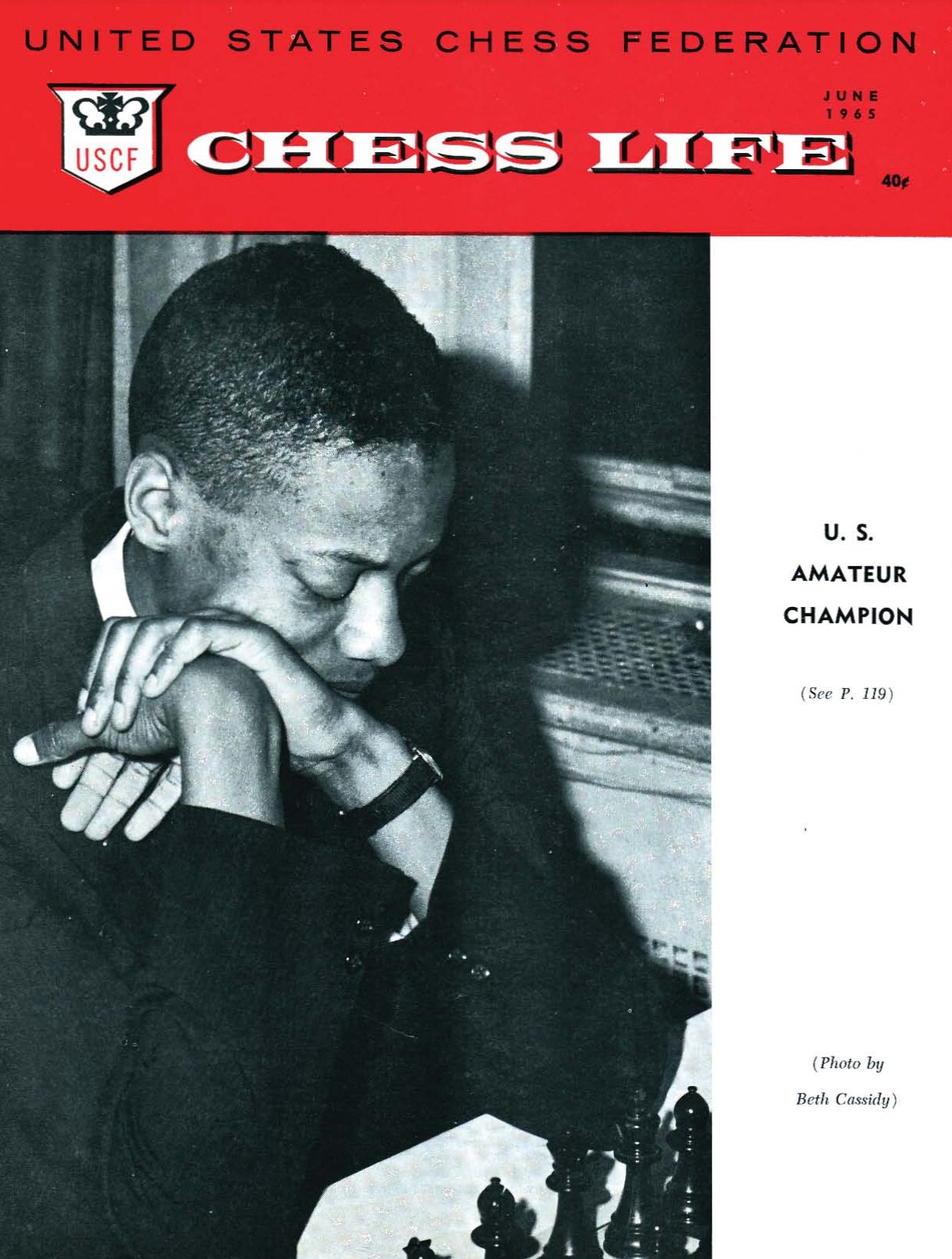
Walter Harris on the March 1964 cover of Chess Life
and Frank Steet on the June 1965 edition.
After Harris came Frank Street who was having success in Baltimore, Maryland area and earned masterdom in 1963. It is interesting that both Harris and Street were both at UCLA pursuing professional careers in physics and advanced mathematics. A year later, Street would later be immortalized on the June 1965 cover of Chess Life after winning the 1965 U.S. Amateur Championship. Street won the club championship at the Washington Chess Divan by defeating his one-time mentor Kenneth Clayton in the last round. Clayton would become the fourth Black man to earn the National Master title.
.jpg)
Kenneth Clayton analyzing with teen prodigy Baraka Shabazz. He was the 4th Black player to earn the U.S. National Master title behind Walter Harris (1963), Frank Street (1965), and Leroy Jackson (1966).
Also in the late 60s was another horde of Black masters emerging. FM Ervin Middleton (the first Black FM), Charles Covington (a multi-talented musician) and Leroy Jackson all grabbed their share of spotlight at this time. Jackson (who later became Leroy Muhammad) was a St. Louis phenom who racked up an impressive record in the late 60s. At the tender age of 17, he started his rampage.
The year 1966 was magical for Muhammad. He won the St. Louis city championship four consecutive years from 1966-1969 and the Missouri State Championship three consecutive years from 1966-1968. Muhammad also tied for 1st place in the 1966 Eastern Open. He then won 1st junior in the 1966 U.S. Open with 8½-4½ beating future legend Walter Browne (New York) and Salvatore Matera (New York).
While it is difficult to trace all of this activity to the “Fischer Boom” there was certainly an excitement brewing around chess. This excitement would also touch players in the Caribbean and Africa as Jamaica’s community was brought to life in the late 60s and formally recognized by FIDE in 1972. The legendary Enos Grant and John Powell were instrumental in putting the island into the fraternity of chess nations.
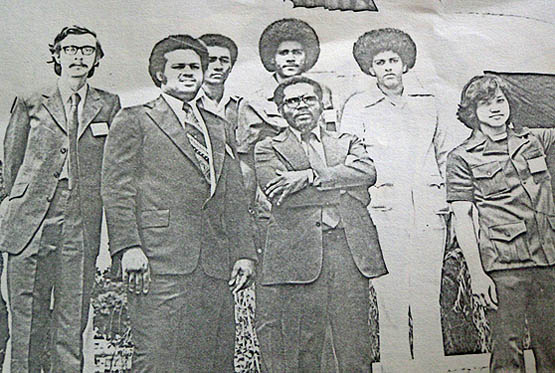
Jamaica’s team at the opening ceremony of the 23rd World Students’ Chess Olympiad in Caracas, Venezuela, 7-22 August, 1976. From left: Bob Wheeler, John Powell, Peter Mundell, David Hunt, Enos Grant (Captain/delegate), Orrin Tonsingh, and Sheldon Wong. Photo from Jamaica Ambassadors Chess Academy.
With Fischer as the new World Champion, chess took center stage. For Africa and the Caribbean, chess was more prominent in the English-speaking nations while French-speaking nations took more to draughts (10×10 checkers). Given social discord of apartheid, it is ironic that South Africa had one of the most promising players in Africa in Watu Kobese.
Kobese was recognized as a young talent and studied in Germany with legendary author GM Ludek Pachman for 3½ years, but his growth would be stunted after South Africa fell under FIDE sanctions. It was a bitter-sweet scenario since it prevented Kobese from competing in FIDE events. However, Kobese’s sacrifice for social principle bore fruit when a former protégé named Kenny Solomon became South Africa’s first Grandmaster 30 years later.
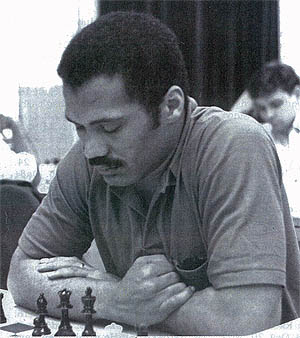
A rare photo of IM Emory Tate at the 1988 New York Open. Over the years, Tate has electrified the chess world with many brilliant, attacking games. Here’s one of them. Photo by Jerry Bibuld.
During this time in the 80s, a wave of masters were rising in the U.S. Players such as Emory Tate, Morris Giles, Alfred Blake Carlin, Norman Rogers, Ronald Simpson, William Morrison and Stephen Booth (now Stephen Muhammad) were making big impacts. You also had female prodigy Baraka Shabazz to grab the spotlight. However there was one shining star waiting in the wings… waiting for his turn. His name was Maurice Ashley.
Coming from Brooklyn’s “Black School of Chess,” the Jamaican-born Ashley earned his marks at the hard scrabble chess parks of New York, but also began to benefit from his association with other hungry masters. Competition was fierce and everyone was seeking to prove that they were capable of playing at a high level. Ashley had already shown signs of skill when he and Tate both earned International Master (IM) norms at the 1988 New York Open. However it wasn’t smooth sailing for Ashley.
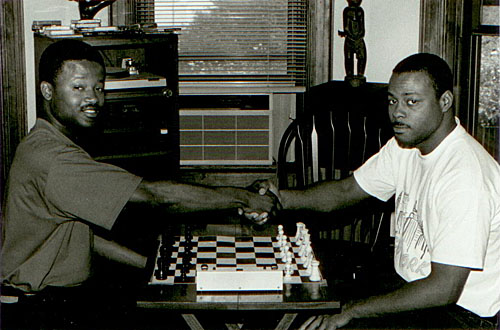
Maurice Ashley vs. William Morrison
30-game Black Bear Challenge
Photo by Jerome Bibuld.
Ashley faced trouble with securing resources for improvement, but had already reached 2555 USCF and 2420 FIDE. Ashley added another IM norm at the 1988 World Open and was featured in the October 1989 issue of Chess Life. In fact, FM Ron Buckmire of Grenada/Barbados had been featured months earlier. Media had started to catch on! Ashley then embarked on an overseas campaign which included Gronginen 1990 (Netherlands) and Lyon 1990 (France).
After apartheid was dismantled in 1990, Kobese had lost valuable time and momentum to become the first Grandmaster (GM) in Sub-Saharan Africa. While Tunisia’s Slim Bouaziz and Morocco’s Hichem Hamdouchi would become the first two GMs of Africa (1993 and 1994 respectively), Kobese would earn his IM title in 1995. There were spirited discussions on who would be the first Grandmaster of the Black world. Names were bandied about, but Tate and Kobese were always near the top of the list.
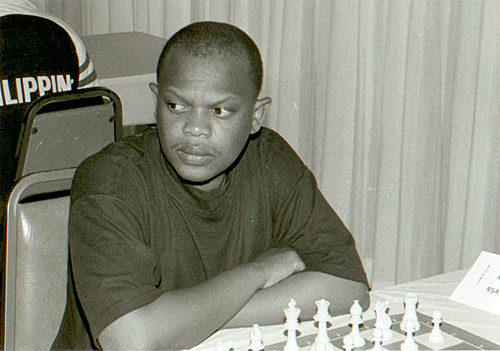
IM Watu Kobese at 1998 U.S. Masters in Honolulu, Hawaii.
He had beaten Judit Polgar in Cap d’Agde that year.
Photo by Jerry Bibuld.
While there was undeniable talent in the African Diaspora, there seemed to be a shortage of opportunities. Jerry Bibuld, an important name in “Afro-American chess” set forth to provide opportunities for Black players in the U.S., Africa and the Caribbean. He traveled to Africa and the Caribbean to hold seminars and direct tournaments, but also sent equipment, books and magazines to federations (South African, Uganda and Mozambique in particular). He was also one of the main antagonists at getting South Africa’s chess body suspended by FIDE for what he deemed as racist policies to keep Black players from representing the country.
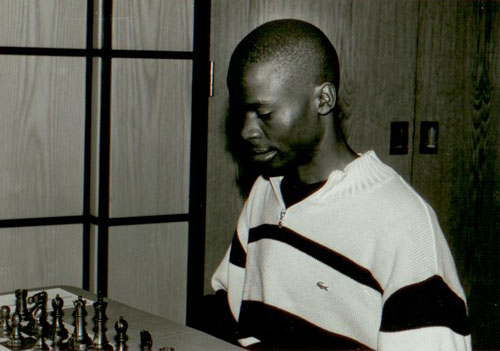
Portrait of Zambia’s (then IM, now GM) Amon Simutowe.
Photo by Jerry Bibuld.
While there were strong results by a number of players including five IMs in Angola and a few in Nigeria, there were no breakthroughs in sub-Saharan Africa. However, a little boy was sharpening his tools in a small town of Ndola, Zambia. Amon Simutowe was destroying local competition and proceeded to win the 1996 national championship of Zambia at age 14. Two years later, he earned his IM title at the African 4.3 subzonal then won the 1999 African Junior by a whopping 12/13 score.
Meanwhile, Maurice Ashley had scored his final GM norm and in 1999 became the world’s first Black Grandmaster of record! What was the impact of this?
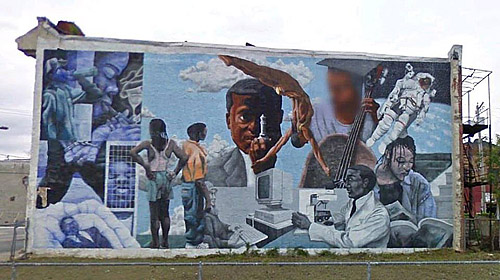
Grandmaster Maurice Ashley appears in a mural in Philadelphia. According to Ray Robinson, the mural was painted in 1998 by Calvin Johnson and was sponsored by Mercy Health Care Systems.
# # #
The Drum Majors of Chess: Part One
(Pioneers of 19th Century)
The Drum Majors of Chess: Part Two
(The Rise of the Black Chess Master)
The Drum Majors of Chess: Part Three
(The Future: 100 Black GMs by 2100)

Daaim, like any goood chess player we always look for the next move. I hope yours is the upcoming book “African Americans in Chess”.
thanks
Well Daaim, 1st steps are the hardest then momentum carries the task. Since chess is such an enigmatic subject many in the African- American community as well as other social groups rejects the game as simply beyond comprehension. I think we need a media campaign to express chess as a delightfully simple and joyous game for which it is. To new comer I often describe chess as only a little more advance than tic-tac-toe.
Yeah but u gotta be able to prove it as well, nice sounding words dont cut the mustard.what do u mean when u say AA community reject the game as behyond comprehension?
Hello Lionel, I often speak to parents, educators, students and even relatives about the benefits of learning the game. It is often a very short conversation. The look of puzzlement or why do you do it it look, I can see fear in their face. Of course this is encountered in many cultural backgrounds but being of African American ancestry I see it more vividly in my culture and therefore have a stronger sense of responsibility to share the game.
gOOD day Chessdrummers and cleveland, Um not sure where live but i must say the chessplayers in the community that i LEARNED the game in are all very confident and competent players, Traditionalism is the problem we have in chess as far as the AA community you speak of we will replace the old chess with ULTRAMODERNISM and the issue will be gone. Oh Daaim good point! We may need a forum on the subject , maybe its a good idea!, do some analysis on some of the black chess or just meditate on the issue, who KNOWS?
Hello Daaim and Lionel, As our departed Soul Brother James Brown said, Please! Please! Please! Share your feedback. I have been considering just this issue, “A marketing campaign to address African-American and chess. Since a picture is worth a thousand words what better way to implore main stream acceptance of chess than through pictures and social media. My initial thought for a starting plan would be to obtain pictures of well recognized AA at a chess board. Not our great African-Americans with chess credentials but prominent individual(s) with wide mainstream recognition. This thought that has been sticking in my mind is a picture of Venus and Serena at a chess board. This would incorporate into the viewing public the “family concept”, a father and mother (King and Queen) working together for the good of the children growing up with fierce tennis competition requiring technical and strategic planning and competing over the world against world challengers as well as each other. (I think about the competitive relationship my brother and I often had in basketball, and a special game we created ourselves whereas the loser would often end up crying). Anyway, I am reviewing agents to establish contacts and protocol for securing the sisters interest and support. I am hoping as a by-product this will bring honor and recognition to the family especially the father and mother who had foresight to make the sisters the success they are. Even if the sister are only chess players on the tennis court , the ideal that they are learning chess can and will motivate many youth to challenge themselves to learn this great game. Please share your feedback and any desire to collaborate in a media campaign to promote chess. Hint Hint, Maybe the chess drum could be the contact organization. Would love to discuss this further.